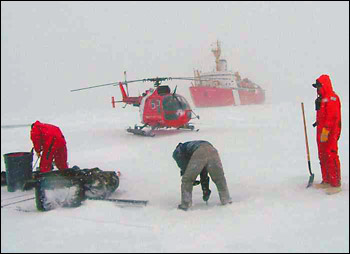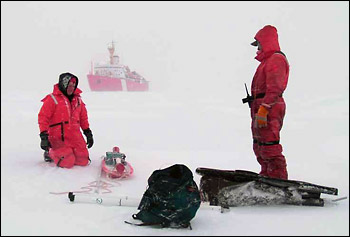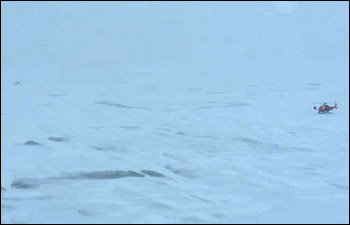Please note: You are viewing
the unstyled version of this website. Either your browser does not support CSS
(cascading style sheets) or it has been disabled. Skip
navigation.
Rick KrishfieldSeptember 1, 2006
In Dispatch 11, the shipboard optical studies by Jiuxin Shi and Yutian Jiao (Ocean University of China) were described. On this day, they would like to make measurements beneath the sea ice for comparison. The Chinese scientists and Will Ostrom are shuttled by helicopter to a site not far from the ship where they use a 10" diameter motorized auger to drill a hole through the ice to lower their optical profiler into the seawater. While they would prefer a day with more sunlight, they must settle for a snowy blustery day. Meanwhile, Jennifer Hutchings, Pat McKeown, and Ian Green are transported also by helicopter about one-third of a mile away from the ship with an instrument to measure the thickness of sea ice using an electromagnetic pulse to discern the depth where salinity changes between the ice and seawater. Sea ice is typically very fresh (less than 5 parts per thousand of salts) compared to seawater (which is on the order 30 parts per thousand). While the instrument is towed over the ice on a sled, measurements are taken approximately every 2 m (6 ft). Pat also occasionally drills 2" diameter holes with a manual auger to be used to verify the instrument data. Ian stands watch with a rifle to guard against polar bears. On this day, this group covers approximately 1/3 mile over an ice floe that varies from 2.5 to 0.8 m (8 to 2 ft) in thickness. The snow is rather light at the start of these operations, by picks up along with the wind. It's not quite true "white out" conditions by the time everyone returns to the ship, but it is getting close. Last updated: October 7, 2019 | |||||||||||||||||||
Copyright ©2007 Woods Hole Oceanographic Institution, All Rights Reserved, Privacy Policy. | |||||||||||||||||||





